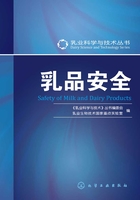
参考文献
[1] Enattah N S,et al.Independent introduction of two lactase-persistence alleles into human populations reflects different history of adaptation to milk culture.Am J Hum Genet,2008,82:57-72.
[2] McDowell B,et al.Failing Grade.Chain leader,1998,3:28.
[3] Altekruse S F,et al.Consumer knowledge of food borne microbial hazards and food-handling practices.J Food Prot,1999,59:287-294.
[4] 孙振科.城市居民40户厨房食品卫生状况调查.职业与健康,2004,20(12):94-95.
[5] De Kruif CG,Holt C.Casein micelle structure,functions and interactions,advanced dairy chemistry:Vol1.3rd edition.Springer US,Kluwer academic/plenum publishers,2003:233-276.
[6] Jensen RG.Invited review-The composition of bovine milk lipids:Januarary 1995 to December 2000.J Dairy Sci,2006,85:295-350.
[7] Bisig W,et al.influence of processing on the fatty acid composition and the content of conjugated linoleic acid in organic and conventional dairy products-a review.Lait,2007,87:1-19.
[8] Fox PF,Kelly AL.Indigenous enzymes in milk:overview and historical aspects Part 2.Int Dairy J,2006,16:517-532..
[9] Kelly AL,Fox PF.Indigenous enzymes in milk:a synopsis of future research requirements.Int Dairy J,2006,16:707-715..
[10] Van schothorst M,et al.Risk of Microbial Risk Assessmen.t Presented at the International Life Science Institute Europe.General Assembly Workshop:the Risk of Risk Assessment in Foods,18 Feb,Brussels,Belgium.
[11] National Acamedy of Sciences(NAS).Anevolution of the Salmonella problem.Committee on Salmonella,Division of biology and agriculture,National research council,National Acamedy of Sciences,Washington DC,1969.
[12] Corlett DA.Risk assessment within the HACCP system.Food Control,1991,2:71-72.
[13] NACMCF.Hazard analysis and critical control point principles and application guidelines.J Food Prot,1998,61:1246-1259.
[14] NACMCF.Principles of risk assessment for illness caused by food borne biological agents.J Food Prot,1998,61:1071-1074.
[15] Joint FAO/WHO Expert consultation on the application of risk management to food safety.Rome,Italy,1996.
[16] Kaplan S.The words of risk analysis.Risk Anal,1997,17:407-417.
[17] National Research Council(NRC).Risk assessment in the federal government:managing the process.Committee on The Institutional Means for Assessment of Risks to Public Health.Washington DC:National academy press,1983.
[18] FAO[http://www.fao.org/ag/agn/agns/jecfa/JECFA72% 20Summary% 20Versio n% 2016% 20% 20Mar% 20FINAL%20rev%20(2).pdf].
[19] WHO(http://www.who.int/foodsafety/chem/summary72 _ rev.pdf).
[20] 钟凯,韩蕃璠,郭丽霞,严卫星等.食品安全风险的认知学特征及风险交流策略.中国食品卫生杂志,2013,25(6):568-570.
[21] 罗季阳,张晓娟,李经津,陈志锋,罗祎等.欧盟食品风险交流机制和策略研究.食品工业科技,2011,32(7):360-362.
[22] Ronald H S等.食品安全手册.北京:中国农业大学出版社,2006.
[23] 张敬平等.乳制品检测传感器与传感技术.北京:化学工业出版社,2013.
[24] 许晓曦等.乳品安全与质量控制.北京:科学出版社,2012.
[25] 戚亚梅.食品安全目标及其管理应用.中国畜牧杂志,2007,43(6):14-18.
[26] Mansel W G,et al.Improving the Safety and Quality of Milk.US:CRC press & Woodhead publishing limited,2010.
[27] John W F,al.Encyclopedia of Dairy Sciences.UK:Academic Press of Elsevier,2011.
[28] 罗祎等.食品安全风险分析-化学危害评估.北京:中国质检出版社,2012.
[29] Report of the joint FAO/WHO Expert consultation.application of risk communication to food standards and food safety issues.Rome,1998.
[30] Griffith C,Worsfold D,Mitchell R.Food preparation,risk communication and the consumer.Food Control,1998,(9):225-232.
[3 1] Bier V M.On the state of the art:risk communication to the public.Reliability Engineering and System Safety,2001,71:139-150.
[32] 韩刚.浅谈牛奶的营养价值.中国奶牛,1997,3:46-48.
[33] 张鹏飞.论牛奶营养与健康.内蒙古教育,2012,3:39-40.
[34] 顾沛沛,丁春华.牛奶的营养、功能与科学饮用.第三届中国奶牛发展大会论文集,2008.